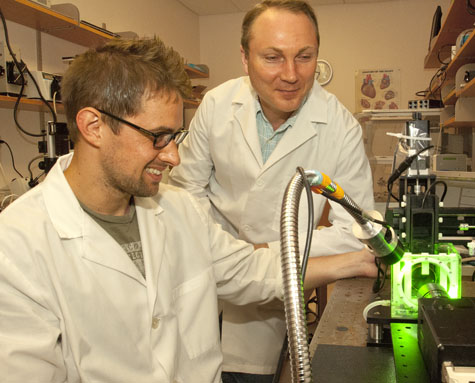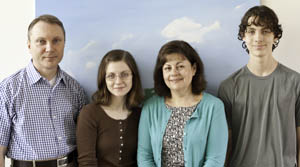
More than 5 million Americans struggle with atrial fibrillation, a dangerous heart condition that can increase the risk of stroke and heart deterioration. While ventricular fibrillation can be treated successfully with implantable defibrillators, similar shock treatments for atrial fibrillation are intolerable for patients. Many say the atrial defibrillation is so painful that they would rather live with the risk of death than be shocked again.
Igor Efimov, PhD, the Lucy & Stanley Lopata Distinguished Professor of Biomedical Engineering in the School of Engineering & Applied Science, and a member of the Washington University in St. Louis community since 2004, is working to resolve that quandary. He and his research team are developing an implantable atrial defibrillator that restores the heart’s rhythm with low-energy shocks, an innovation that will make defibrillation relatively painless.
“Efimov is just amazing,” says Richard Schuessler, PhD, research professor of surgery at the Washington University School of Medicine in St. Louis and longtime colleague. “(He is) one of the most creative people I know. Sometimes I’m actually afraid to talk to him because I’ll start off and all of a sudden he’ll say, ‘oh, oh, oh, did you see this article in Science, or ‘I’ve been talking to this guy and …’ He is always bubbling with ideas.”
Childhood in Siberia
For Efimov, the journey to a major research institution in the heart of America began in the much cooler Siberian hinterlands of the Soviet Union. He grew up in a secret town in Siberia called Krashnoyarsk-26.
Stalin decreed the town be built after Winston Churchill’s Iron Curtain speech in 1946. The speech put Stalin on notice that the Soviet Union and the West, allies during the war, were now on hostile terms.
The people of Krashnoyarsk-26 processed plutonium and built spy satellites.
“My hometown was created by Stalin’s decree,” Efimov says, “and so was my alma mater, the Moscow Institute of Physics and Technology, whose creation was another side effect of Churchill’s Iron Curtain speech.
Efimov earned a master’s degree in experimental nuclear physics at the Institute.
“After I got my degree,” he says, “I typed my last name in PubMed and I got hits on papers in elementary particle physics that had hundreds of authors. I realized that I would be part of such huge teams it would be difficult to make a personal contribution. So I decided to go into biology instead,” he says.
He had never supposed he might emigrate. Not only had he grown up in a secret town, he had been trained in control theory relevant to intercontinental ballistic missile systems guidance in exchange for exemption from the draft. “I never thought they’d let me leave,“ he says.
But in 1991 there was a putsch in Russia, and that changed everything. “I defended my dissertation on Christmas Day, 1991,” Efimov says. “After that it had to go to some state agency for ratification, which arrived in March 1992. A month or two later Yeltsin disbanded the KGB and opened the borders.”
“I immediately started applying for postdoctral postions in the United States and Europe,” Efimov says.
“I took the first position I was offered,” he says, “and we left with two suitcases and all my savings, which was 800 rubles. At the exchange rate of the time, they were worth six or seven dollars.” He bought the airline tickets with money from a revolving slush fund set up by recent Russian expatriates to help other Russians.
After appointments at several other universities, he arrived at WUSTL in 2004. He also has secondary appointments in cell biology, physiology, radiology and medicine in the School of Medicine.
The heart: a highly complex electrical device
Efimov’s research specialty is disturbances of cardiac rhythm known as arrhythmias, a term that includes a large number of very different conditions.
One of the most frightening, however, is ventricular fibrillation, or V-fib, in which the muscle in the major pumping chambers of the heart quiver uselessly instead of pumping rhythmically.
How could this happen? The answer hinges on the fact that cardiac muscle cells have the ability, usually reserved for nerve cells, to initiate an action potential, or traveling wave of electrical activity, on their own.
While this ability is normally suppressed, when something goes wrong, it can lead to electrical impulses that race around and around the heart instead of moving from one end of the heart to the other and then stopping. When an entire chamber of the heart is involved in these “re-entry circuits,” it quivers chaotically and is said to be fibrillating.
Because this is not simple behavior Efimov is understandably skeptical that it will yield to simple treatments.
Reductionism never gets there from here
In an editorial in a recent issue of Circulation Research, he remarks that cardiac physiology has long been seduced by reductionism, the idea that a system can be understood by understanding its parts.
He dates the shift toward reductionism to 1952, when Alan Lloyd Hodgkin and Andrew Huxley described action potentials in the squid giant axon.
Drilling down, cardiovascular physiologists focussed on the heart, then heart tissue, than myocytes, then ion channels in myocytes.
But, Efimov says, the simpler things got, the more complex they became. Ion channels have many isoforms and subunits, and unexpected auxiliary proteins. They are also part of complex signaling pathways activated by a diverse array of electric and mechanical stimuli.
Worse, therapies based on this reductive approach consistently haven’t panned out.
“I believe it is becoming obvious to pretty much everyone in the field that we have to move toward integration now,” Efimov says. “We have to take all this knowledge and create a systemic, holistic understanding of the heart if we are going to deliver on our promises.”
This is the lodestar by which he tries to chart the course for his laboratory.
One of his innovations is to study cardiovascular problems in human hearts rather than in the hearts of mice, the most popular animal model in cardiophysiology.
He has established connections with local institutions that supply his lab with human hearts. The hearts are either diseased ones removed from patients undergoing heart transplants or “non-failing” hearts that have been donated for research but are considered unsuitable for transplantation.
Using voltage-sensitive dyes his lab creates maps in which invisible waves of electrical potentials sweeping across the heart’s chambers are rendered as vibrantly visible waves of color.
Although the program is only three years old, the work has already demonstrated that human hearts are quite different from those of mice. (See “New study calls into question reliance on animal models in cardiovascular research.”)

Another target of Efimov’s research is atrial fibrillation. Again Efimov has looked for a therapy that treats the whole heart, not just its parts.
Ventricular defibrillators have been implanted in patients for 30 years, and clinical studies show they save lives. But patients with atrial fibrillation are conscious when their hearts are shocked and the shocks are painful beyond endurance.
Efimov’s team has devised a painless implantable defibrillator that “unpins” destructive electric circuits in the heart by delivering low-energy shocks to their “anchor points.”
He has founded a company called CardiaLen to develop the defibrillator and if everything goes as planned, the defibrillator will enter stage I clinical trials in about a year.
“If I could find a way to pay for it I would quit my job and go be a post-doc in his lab,” Schuessler says.
Fast facts about Igor Efimov
In his suitcases brought from Russia: Clothes, but also pots and pans. At the time, he says, Russians were under the impression they had to bring dishes, pots and pans when emigrating.
Where he first celebrated Christmas: Fermilab in Batavia, Ill. The Russian expatriate community there throws a proper Russian Christmas, complete with Ded Moroz and Snegurochka.
Favorite meal: Borscht. How predictable is that, he says, adding that borscht is actually Ukrainian but his wife is Ukrainian and she does it perfectly.
Strangest treatment for heart disease encounterd: In the 1950s, some doctors would open the patient’s chest, scratch the heart with a file and staunch the bleeding with asbestos powder. “Unfortunately it didn’t work very well,” he says.
Service to Russian community: Columnist for Russian newspaper Gzt.ru, the online version of the Moscow newspaper Gazeta; member of the board of directors of russiandoctors.org, which sponsors medical missions; and president of the Russian American Science Association, which encourages peer-reviewed research on the Western model in Russia.